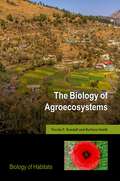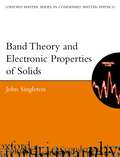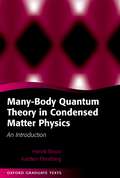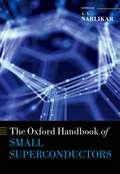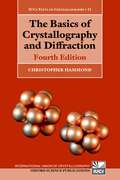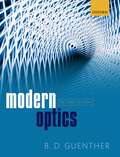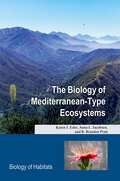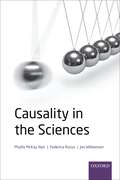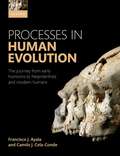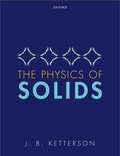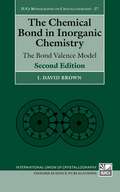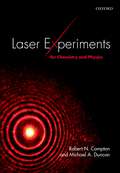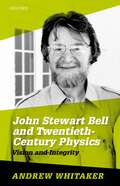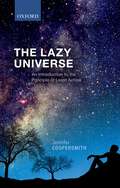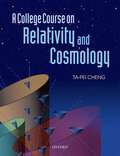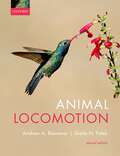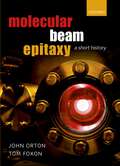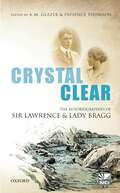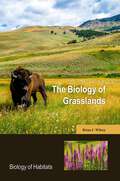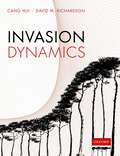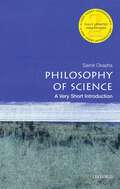- Table View
- List View
The Biology of Agroecosystems (Biology of Habitats Series)
by Nicola Randall Barbara SmithSince the advent of agriculture approximately 12,000 years ago, human activity has created a unique set of ecosystems. However, the recent development of world markets, rapid technological advances, and other changes to farming practices have led to hugely increased pressures on farm habitats and organisms. Global human populations are rising and diets are becoming ever more complicated, leading to unrelenting requirements for increased levels of food production. Natural biotopes are becoming increasingly fragmented as agricultural activities expand around them. "Agroecosystems" now occur from the tropics to subarctic environments and comprise systems as varied as annual crops, perennial grasslands, orchards, and agroforestry systems. They presently cover almost 40% of the terrestrial land surface and significantly shape landscapes at a global scale. This key addition to the OUP Biology of Habitats Series provides a novel perspective on agroecosystems, summarising our current understanding of the basic and applied aspects of these important and complex habitats, whilst focusing on environmental concerns in the context of global change. The Biology of Agroecosystemsis is for both senior undergraduate and graduate students taking courses in agroecology, farmland ecology, conservation, and agriculture as well as the many professional ecologists, conservation biologists, and land managers requiring a concise overview of agroecology.
Band Theory and Electronic Properties of Solids (Oxford Master Series in Condensed Matter Physics #2)
by John SingletonThis book provides an introduction to band theory and the electronic properties of materials at a level suitable for final-year undergraduates or first-year graduate students. It sets out to provide the vocabulary and quantum-mechanical training necessary to understand the electronic, optical and structural properties of the materials met in science and technology and describes some of the experimental techniques which are used to study band structure today. In order to leave space for recent developments, the Drude model and the introduction of quantum statistics are treated synoptically. However, Bloch's theorem and two tractable limits, a very weak periodic potential and the tight-binding model, are developed rigorously and in three dimensions. Having introduced the ideas of bands, effective masses and holes, semiconductor and metals are treated in some detail, along with the newer ideas of artificial structures such as super-lattices and quantum wells, layered organic substances and oxides. Some recent `hot topics' in research are covered, e.g. the fractional Quantum Hall Effect and nano-devices, which can be understood using the techniques developed in the book. In illustrating examples of e.g. the de Haas-van Alphen effect, the book focuses on recent experimental data, showing that the field is a vibrant and exciting one. References to many recent review articles are provided, so that the student can conduct research into a chosen topic at a deeper level. Several appendices treating topics such as phonons and crystal structure make the book self-contained introduction to the fundamentals of band theory and electronic properties in condensed matter physic today.
Many-Body Quantum Theory in Condensed Matter Physics: An Introduction (Oxford Graduate Texts)
by Henrik Bruus Karsten FlensbergThis book is an introduction to the techniques of many-body quantum theory with a large number of applications to condensed matter physics. The basic idea of the book is to provide a self-contained formulation of the theoretical framework without losing mathematical rigor, while at the same time providing physical motivation and examples. The examples are taken from applications in electron systems and transport theory. On the formal side, the book covers an introduction to second quantization, many-body Green's function, finite temperature Feynman diagrams and bosonization. The applications include traditional transport theory in bulk as well as mesoscopic systems, where both the Landau-Büttiker formalism and recent developments in correlated transport phenomena in mesoscopic systems and nano-structures are covered. Other topics include interacting electron gases, plasmons, electron-phonon interactions, superconductivity and a final chapter on one-dimensional systems where a detailed treatment of Luttinger liquid theory and bosonization techniques is given. Having grown out of a set of lecture notes, and containing many pedagogical exercises, this book is designed as a textbook for an advanced undergraduate or graduate course, and is also well suited for self-study.
The Oxford Handbook of Small Superconductors (Oxford Handbooks)
This handbook is about a remarkable set of materials that are technically referred to as "mesoscopic superconductors", which for all practical purposes are tiny or small in their dimensions, ranging from a few micrometers down to a nanometer. At this level of smallness, the superconducting properties are dramatically changed, showing the dominance of quantum effects. Ground breaking research studies of small superconductors have emerged, and in a world obsessed with miniaturization of electronic device technology, small superconductors acquire even greater relevance and timeliness for the development of exciting novel quantum devices. The chapters, contributed by noted researchers and frontrunners in the field from 15 countries, are presented in three parts, namely progress in basic studies, materials specific research, and advances in nanodevices. The contents of the handbook should be of immediate interest to advanced level university students and researchers particularly in physics, materials science, nanoscience and engineering departments. Various reviews and overviews appearing in the book should answer the queries and curiosities of non-specialists interested in nanoscale superconductivity. At the start, the book carries an extended introduction for readers new to the field. The book should also appeal to scientists and engineers from electronic industries interested in knowing the current status of the theory, manufacture, and future of mesoscopic superconductors. In doing so, this volume offers the opportunity to engage with cutting edge research in one of the most exciting fields of physics today and tomorrow.
The Basics of Crystallography and Diffraction (International Union of Crystallography Texts on Crystallography #21)
by Christopher HammondThis book provides a clear and very broadly based introduction to crystallography, light, X-ray and electron diffraction - a knowledge which is essential to students in a wide range of scientific disciplines but which is otherwise generally covered in subject-specific and more mathematically detailed texts. The text is also designed to appeal to the more general reader since it shows, by historical and biographical references, how the subject has developed from the work and insights of successive generations of crystallographers and scientists. The book shows how an understanding of crystal structures, both inorganic and organic may be built up from simple ideas of atomic and molecular packing. Beginning with (two dimensional) examples of patterns and tilings, the concepts of lattices, symmetry point and space groups are developed. 'Penrose' tilings and quasiperiodic structures are also included. The reciprocal lattice and its importance in understanding the geometry of light, X-ray and electron diffraction patterns is explained in simple terms, leading to Fourier analysis in diffraction, crystal structure determination, image formation and the diffraction-limited resolution in these techniques. Practical X-ray and electron diffraction techniques and their applications are described. A recurring theme is the common principles: the techniques are not treated in isolation. The fourth edition has been revised throughout, and includes new sections on Fourier analysis, Patterson maps, direct methods, charge flipping, group theory in crystallography, and a new chapter on the description of physical properties of crystals by tensors (Chapter 14).
Modern Optics, 2nd edition
by B. D. GuentherModern Optics is a fundamental study of the principles of optics using a rigorous physical approach based on Maxwell's Equations. The treatment provides the mathematical foundations needed to understand a number of applications such as laser optics, fiber optics and medical imaging covered in an engineering curriculum as well as the traditional topics covered in a physics based course in optics. In addition to treating the fundamentals in optical science, the student is given an exposure to actual optics engineering problems such as paraxial matrix optics, aberrations with experimental examples, Fourier transform optics (Fresnel-Kirchhoff formulation), Gaussian waves, thin films, photonic crystals, surface plasmons, and fiber optics. Through its many pictures, figures, and diagrams, the text provides a good physical insight into the topics covered. The course content can be modified to reflect the interests of the instructor as well as the student, through the selection of optional material provided in appendixes.
The Biology of Mediterranean-Type Ecosystems (Biology of Habitats Series)
by Karen J. Esler Anna L. Jacobsen R. Brandon PrattThe world's mediterranean-type climate regions (including areas within the Mediterranean, South Africa, Australia, California, and Chile) have long been of interest to biologists by virtue of their extraordinary biodiversity and the appearance of evolutionary convergence between these disparate regions. These regions contain many rare and endemic species. Their mild climate makes them appealing places to live and visit and this has resulted in numerous threats to the species and communities that occupy them. Threats include a wide range of factors such as habitat loss due to development and agriculture, disturbance, invasive species, and climate change. As a result, they continue to attract far more attention than their limited geographic area might suggest. This book provides a concise but comprehensive introduction to mediterranean-type ecosystems. It is an accessible text which provides an authoritative overview of the topic. As with other books in the Biology of Habitats Series, the emphasis in this book is on the organisms that dominate these regions although their management, conservation, and restoration are also considered.
Causality in the Sciences
There is a need for integrated thinking about causality, probability and mechanisms in scientific methodology. Causality and probability are long-established central concepts in the sciences, with a corresponding philosophical literature examining their problems. On the other hand, the philosophical literature examining mechanisms is not long-established, and there is no clear idea of how mechanisms relate to causality and probability. But we need some idea if we are to understand causal inference in the sciences: a panoply of disciplines, ranging from epidemiology to biology, from econometrics to physics, routinely make use of probability, statistics, theory and mechanisms to infer causal relationships. These disciplines have developed very different methods, where causality and probability often seem to have different understandings, and where the mechanisms involved often look very different. This variegated situation raises the question of whether the different sciences are really using different concepts, or whether progress in understanding the tools of causal inference in some sciences can lead to progress in other sciences. The book tackles these questions as well as others concerning the use of causality in the sciences.
Processes in Human Evolution: The journey from early hominins to Neanderthals and modern humans
by Francisco J. Ayala Camilo J. Cela-CondeThe discoveries of the last decade have brought about a completely revised understanding of human evolution due to the recent advances in genetics, palaeontology, ecology, archaeology, geography, and climate science. Written by two leading authorities in the fields of physical anthropology and molecular evolution, Processes in Human Evolution presents a reconsidered overview of hominid evolution, synthesising data and approaches from a range of inter-disciplinary fields. The authors pay particular attention to population migrations - since these are crucial in understanding the origin and dispersion of the different genera and species in each continent - and to the emergence of the lithic cultures and their impact on the evolution of cognitive capacities. Processes in Human Evolution is intended as a primary textbook for university courses on human evolution, and may also be used as supplementary reading in advanced undergraduate and graduate courses. It is also suitable for a more general audience seeking a readable but up-to-date and inclusive treatment of human origins and evolution.
The Physics of Solids
by J. B. KettersonThis comprehensive text covers the basic physics of the solid state starting at an elementary level suitable for undergraduates but then advancing, in stages, to a graduate and advanced graduate level. In addition to treating the fundamental elastic, electrical, thermal, magnetic, structural, electronic, transport, optical, mechanical and compositional properties, we also discuss topics like superfluidity and superconductivity along with special topics such as strongly correlated systems, high-temperature superconductors, the quantum Hall effects, and graphene. Particular emphasis is given to so-called first principles calculations utilizing modern density functional theory which for many systems now allow accurate calculations of the electronic, magnetic, and thermal properties.
The Physics of Solids
by J. B. KettersonThis comprehensive text covers the basic physics of the solid state starting at an elementary level suitable for undergraduates but then advancing, in stages, to a graduate and advanced graduate level. In addition to treating the fundamental elastic, electrical, thermal, magnetic, structural, electronic, transport, optical, mechanical and compositional properties, we also discuss topics like superfluidity and superconductivity along with special topics such as strongly correlated systems, high-temperature superconductors, the quantum Hall effects, and graphene. Particular emphasis is given to so-called first principles calculations utilizing modern density functional theory which for many systems now allow accurate calculations of the electronic, magnetic, and thermal properties.
The Chemical Bond in Inorganic Chemistry: The Bond Valence Model (International Union of Crystallography Monographs on Crystallography #27)
by I. David BrownThe bond valence model, a description of acid-base bonding, is widely used for analysing and modelling the structures and properties of solids and liquids. Unlike other models of inorganic chemical bonding, the bond valence model is simple, intuitive, and predictive, and is accessible to anyone with a pocket calculator and a secondary school command of chemistry and physics. This new edition of 'The Chemical Bond in Inorganic Chemistry: The Bond Valence Model' shows how chemical properties arise naturally from the conflict between the constraints of chemistry and those of three-dimensional space. The book derives the rules of the bond valence model, as well as those of the traditional covalent, ionic and popular VSEPR models, by identifying the chemical bond with the electrostatic flux linking the bonded atoms. Most of the new edition is devoted to showing how to apply these ideas to real materials including crystals, liquids, glasses and surfaces. The work includes detailed examples of applications, and the final chapter explores the relationship between the flux and quantum theories of the bond.
Laser Experiments for Chemistry and Physics
by Robert N. Compton Michael A. DuncanLasers are employed throughout science and technology, in fundamental research, the remote sensing of atmospheric gases or pollutants, communications, medical diagnostics and therapies, and the manufacturing of microelectronic devices. Understanding the principles of their operation, which underlie all of these areas, is essential for a modern scientific education. This text introduces the characteristics and operation of lasers through laboratory experiments designed for the undergraduate curricula in Chemistry and Physics. Introductory chapters describe the properties of light, the history of laser invention, the atomic, molecular and optical principles behind how lasers work, and the kinds of lasers available today. Other chapters include the basic theory of spectroscopy and computational chemistry used to interpret laser experiments. Experiments range from simple in-class demonstrations to more elaborate configurations for advanced students. Each chapter has historical and theoretical background, as well as options suggested for variations on the prescribed experiments. The text will be useful for undergraduates students in advanced lab classes, for instructors designing these classes, or for graduate students beginning a career in laser science.
John Stewart Bell and Twentieth-Century Physics: Vision and Integrity
by Andrew WhitakerJohn Stewart Bell (1928-1990) was one of the most important figures in twentieth-century physics, famous for his work on the fundamental aspects of the century's most important theory, quantum mechanics. While the debate over quantum theory between the supremely famous physicists, Albert Einstein and Niels Bohr, appeared to have become sterile in the 1930s, Bell was able to revive it and to make crucial advances - Bell's Theorem or Bell's Inequalities. He was able to demonstrate a contradiction between quantum theory and essential elements of pre-quantum theory - locality and causality. The book gives a non-mathematical account of Bell's relatively impoverished upbringing in Belfast and his education. It describes his major contributions to quantum theory, but also his important work in the physics of accelerators, and nuclear and elementary particle physics.
John Stewart Bell and Twentieth-Century Physics: Vision and Integrity
by Andrew WhitakerJohn Stewart Bell (1928-1990) was one of the most important figures in twentieth-century physics, famous for his work on the fundamental aspects of the century's most important theory, quantum mechanics. While the debate over quantum theory between the supremely famous physicists, Albert Einstein and Niels Bohr, appeared to have become sterile in the 1930s, Bell was able to revive it and to make crucial advances - Bell's Theorem or Bell's Inequalities. He was able to demonstrate a contradiction between quantum theory and essential elements of pre-quantum theory - locality and causality. The book gives a non-mathematical account of Bell's relatively impoverished upbringing in Belfast and his education. It describes his major contributions to quantum theory, but also his important work in the physics of accelerators, and nuclear and elementary particle physics.
The Lazy Universe: An Introduction to the Principle of Least Action
by Jennifer CoopersmithThis is a rare book on a rare topic: it is about 'action' and the Principle of Least Action. A surprisingly well-kept secret, these ideas are at the heart of physical science and engineering. Physics is well known as being concerned with grand conservatory principles (e.g. the conservation of energy) but equally important is the optimization principle (such as getting somewhere in the shortest time or with the least resistance). The book explains: why an optimization principle underlies physics, what action is, what `the Hamiltonian' is, and how new insights into energy, space, and time arise. It assumes some background in the physical sciences, at the level of undergraduate science, but it is not a textbook. The requisite derivations and worked examples are given but may be skim-read if desired. The author draws from Cornelius Lanczos's book "The Variational Principles of Mechanics" (1949 and 1970). Lanczos was a brilliant mathematician and educator, but his book was for a postgraduate audience. The present book is no mere copy with the difficult bits left out - it is original, and a popularization. It aims to explain ideas rather than achieve technical competence, and to show how Least Action leads into the whole of physics.
A College Course on Relativity and Cosmology
by Ta-Pei ChengThis advanced undergraduate text introduces Einstein's general theory of relativity. The topics covered include geometric formulation of special relativity, the principle of equivalence, Einstein's field equation and its spherical-symmetric solution, as well as cosmology. An emphasis is placed on physical examples and simple applications without the full tensor apparatus. It begins by examining the physics of the equivalence principle and looks at how it inspired Einstein's idea of curved spacetime as the gravitational field. At a more mathematically accessible level, it provides a metric description of a warped space, allowing the reader to study many interesting phenomena such as gravitational time dilation, GPS operation, light deflection, precession of Mercury's perihelion, and black holes. Numerous modern topics in cosmology are discussed from primordial inflation and cosmic microwave background to the dark energy that propels an accelerating universe. Building on Cheng's previous book, 'Relativity, Gravitation and Cosmology: A Basic Introduction', this text has been tailored to the advanced student. It concentrates on the core elements of the subject making it suitable for a one-semester course at the undergraduate level. It can also serve as an accessible introduction of general relativity and cosmology for those readers who want to study the subject on their own. The proper tensor formulation of Einstein's field equation is presented in an appendix chapter for those wishing to glimpse further at the mathematical details.
Animal Locomotion
by Andrew Biewener Sheila PatekAnimals have evolved remarkable biomechanical and physiological systems that enable their rich repertoire of motion. Animal Locomotion offers a fundamental understanding of animal movement through a broad comparative and integrative approach, including basic mathematics and physics, examination of new and enduring literature, consideration of classic and cutting-edge methods, and a strong emphasis on the core concepts that consistently ground the dizzying array of animal movements. Across scales and environments, this book integrates the biomechanics of animal movement with the physiology of animal energetics and the neural control of locomotion. This second edition has been thoroughly revised, incorporating new content on non-vertebrate animal locomotor systems, studies of animal locomotion that have inspired robotic designs, and a new chapter on the use of evolutionary approaches to locomotor mechanisms and performance.
Molecular Beam Epitaxy: A Short History
by John Orton Tom FoxonThe book is a history of Molecular Beam Epitaxy (MBE) as applied to the growth of semiconductor thin films (note that it does not cover the subject of metal thin films). It begins by examining the origins of MBE, first of all looking at the nature of molecular beams and considering their application to fundamental physics, to the development of nuclear magnetic resonance and to the invention of the microwave MASER. It shows how molecular beams of silane (SiH4) were used to study the nucleation of silicon films on a silicon substrate and how such studies were extended to compound semiconductors such as GaAs. From such surface studies in ultra-high vacuum the technique developed into a method of growing high quality single crystal films of a wide range of semiconductors. Comparing this with earlier evaporation methods of deposition and with other epitaxial deposition methods such as liquid phase and vapour phase epitaxy (LPE and VPE). The text describes the development of MBE machines from the early âhome-madeâ variety to that of commercial equipment and show how MBE was gradually refined to produce high quality films with atomic dimensions. This was much aided by the use of various in-situ surface analysis techniques, such as reflection high energy electron diffraction (RHEED) and mass spectrometry, a feature unique to MBE. It looks at various modified versions of the basic MBE process, then proceed to describe their application to the growth of so-called âlow-dimensional structuresâ (LDS) based on ultra-thin heterostructure films with thickness of order a few molecular monolayers. Further chapters cover the growth of a wide range of different compounds and describe their application to fundamental physics and to the fabrication of electronic and opto-electronic devices. The authors study the historical development of all these aspects and emphasise both the (often unexpected) manner of their discovery and development and the unique features which MBE brings to the growth of extremely complex structures with monolayer accuracy.
Crystal Clear: The Autobiographies of Sir Lawrence and Lady Bragg
by A. M. Glazer Patience ThomsonCrystal Clear takes you behind the scenes in the life of one of the most prominent scientists of the twentieth century, William Lawrence Bragg (WLB) - an innovative genius, who together with his father, William Henry Bragg (WHB) founded and developed a whole new branch of science, X-ray Crystallography. The main body of the text contains the hitherto unpublished autobiographies of both WLB and his wife, Alice. Alice Bragg was a public figure in her own right. She was Mayor of Cambridge and National Chairman of the Marriage Guidance Council among other roles. She and WLB were as different as chalk and cheese. Their autobiographies complement each other to give a rounded picture of the real personalities behind their public appearance. They write of their travels, their family life, their friends and their joys and sorrows. They write most of all about each other. Their younger daughter, Patience Thomson, provides anecdotes and vignettes, bringing her parents to life. She has also included extracts from previously unpublished letters and from articles which Alice Bragg wrote for National newspapers. The result is an unusual insight into the lives of two distinguished people. The two accounts reveal a fascinating interaction between these two characters, neither of whom could have achieved on this scale without the other. There is an underlying love story here which humanises and transforms. This is a unique book, adopting an original viewpoint, which will take the reader far beyond the scope of a normal biography.
Crystal Clear: The Autobiographies of Sir Lawrence and Lady Bragg
by A. M. Glazer and Patience ThomsonCrystal Clear takes you behind the scenes in the life of one of the most prominent scientists of the twentieth century, William Lawrence Bragg (WLB) - an innovative genius, who together with his father, William Henry Bragg (WHB) founded and developed a whole new branch of science, X-ray Crystallography. The main body of the text contains the hitherto unpublished autobiographies of both WLB and his wife, Alice. Alice Bragg was a public figure in her own right. She was Mayor of Cambridge and National Chairman of the Marriage Guidance Council among other roles. She and WLB were as different as chalk and cheese. Their autobiographies complement each other to give a rounded picture of the real personalities behind their public appearance. They write of their travels, their family life, their friends and their joys and sorrows. They write most of all about each other. Their younger daughter, Patience Thomson, provides anecdotes and vignettes, bringing her parents to life. She has also included extracts from previously unpublished letters and from articles which Alice Bragg wrote for National newspapers. The result is an unusual insight into the lives of two distinguished people. The two accounts reveal a fascinating interaction between these two characters, neither of whom could have achieved on this scale without the other. There is an underlying love story here which humanises and transforms. This is a unique book, adopting an original viewpoint, which will take the reader far beyond the scope of a normal biography.
The Biology of Grasslands (Biology of Habitats Series (BOHS))
by Brian WilseyThis accessible text provides a concise but comprehensive introduction to the biology of global grasslands. Grasslands are vast in their extent, with native and non-native grasslands now covering approximately 50% of the global terrestrial environment. They are also of vital importance to humans, providing essential ecosystem services and some of the most important areas for the production of food and fibre worldwide. It has been estimated that 60% of calories consumed by humans originate from grasses, and most grain consumed is produced in areas that were formerly grasslands or wetlands. Grasslands are also important because they are used to raise forage for livestock, represent a source of biofuels, sequester vast amounts of carbon, provide urban green-space, and hold vast amounts of biodiversity. Intact grasslands contain an incredibly fascinating set of plants, animals, and microbes that have interested several generations of biologists, generating pivotal studies to important theoretical questions in ecology. As with other titles in the Biology of Habitats Series, the emphasis is on the organisms that dominate this environment although restoration, conservation, and experimental aspects are also considered.
Invasion Dynamics
by Cang Hui David M. RichardsonHumans have moved organisms around the world for centuries but it is only relatively recently that invasion ecology has grown into a mainstream research field. This book examines both the spread and impact dynamics of invasive species, placing the science of invasion biology on a new, more rigorous, theoretical footing, and proposing a concept of adaptive networks as the foundation for future research. Biological invasions are considered not as simple actions of invaders and reactions of invaded ecosystems, but as co-evolving complex adaptive systems with emergent features of network complexity and invasibility. Invasion Dynamics focuses on the ecology of invasive species and their impacts in recipient social-ecological systems. It discusses not only key advances and challenges within the traditional domain of invasion ecology, but introduces approaches, concepts, and insights from many other disciplines such as complexity science, systems science, and ecology more broadly. It will be of great value to invasion biologists analyzing spread and/or impact dynamics as well as other ecologists interested in spread processes or habitat management.
Invasion Dynamics
by David M. Richardson Cang HuiHumans have moved organisms around the world for centuries but it is only relatively recently that invasion ecology has grown into a mainstream research field. This book examines both the spread and impact dynamics of invasive species, placing the science of invasion biology on a new, more rigorous, theoretical footing, and proposing a concept of adaptive networks as the foundation for future research. Biological invasions are considered not as simple actions of invaders and reactions of invaded ecosystems, but as co-evolving complex adaptive systems with emergent features of network complexity and invasibility. Invasion Dynamics focuses on the ecology of invasive species and their impacts in recipient social-ecological systems. It discusses not only key advances and challenges within the traditional domain of invasion ecology, but introduces approaches, concepts, and insights from many other disciplines such as complexity science, systems science, and ecology more broadly. It will be of great value to invasion biologists analyzing spread and/or impact dynamics as well as other ecologists interested in spread processes or habitat management.
Philosophy of Science: Very Short Introduction (Very Short Introductions)
by Samir OkashaHow much faith should we place in what scientists tell us? Is it possible for scientific knowledge to be fully 'objective'? What, really, can be defined as science? In the second edition of this Very Short Introduction, Samir Okasha explores the main themes and theories of contemporary philosophy of science, and investigates fascinating, challenging questions such as these. Starting at the very beginning, with a concise overview of the history of science, Okasha examines the nature of fundamental practices such as reasoning, causation, and explanation. Looking at scientific revolutions and the issue of scientific change, he asks whether there is a discernible pattern to the way scientific ideas change over time, and discusses realist versus anti-realist attitudes towards science. He finishes by considering science today, and the social and ethical philosophical questions surrounding modern science. ABOUT THE SERIES: The Very Short Introductions series from Oxford University Press contains hundreds of titles in almost every subject area. These pocket-sized books are the perfect way to get ahead in a new subject quickly. Our expert authors combine facts, analysis, perspective, new ideas, and enthusiasm to make interesting and challenging topics highly readable.
